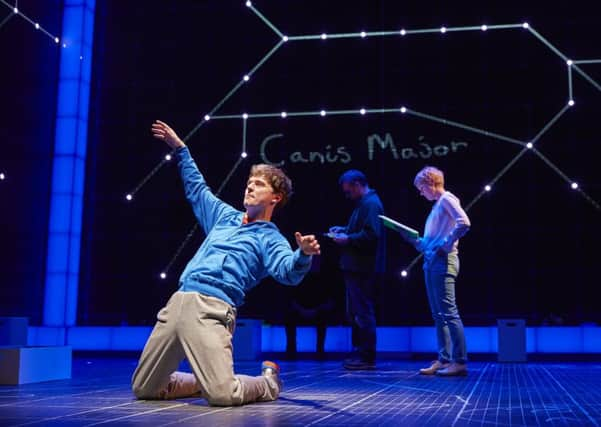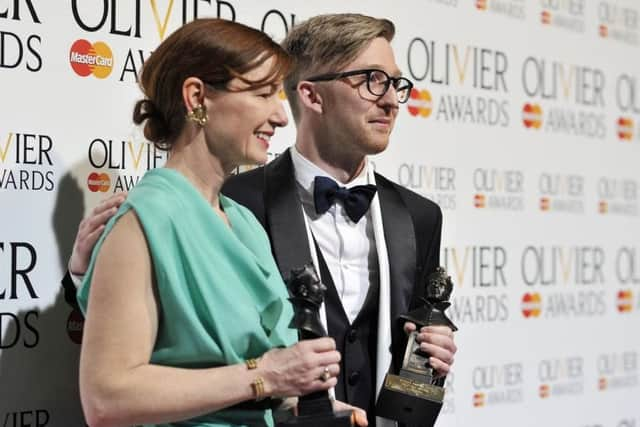Scots duo make The Curious incident... a success


Mark Haddon’s novel, The Curious Incident of the Dog in the Night-Time, is one of the great publishing success stories of the last two decades. Haddon’s story of a teenager with Asperger’s who sets out to solve the murder of a neighbour’s dog won 17 literary prizes and defined the market in crossover fiction.
Though that made it ripe for adaptation into a film or play, Haddon was convinced that it couldn’t be done. The narrative, which unfolds entirely in the mind of 15-year-old Christopher Boone, quirky, obsessive, entirely logical, a whizz at maths but rather less good with humans beings, belonged on the page, not the stage.
Advertisement
Hide AdIn 2012, nine years after Curious Incident was published, a crack team at the National Theatre in London proved him wrong. An adaptation by Fringe-First winning playwright Simon Stephens opened at the Cottesloe, to rave reviews. It transferred to the West End – where it is still playing to packed houses – and, last autumn, opened on Broadway. It has now been seen by nearly half a million people worldwide, and is embarking on its first UK tour, including dates in Edinburgh, Glasgow and Aberdeen.


A key element in the successful transformation of the story from page to stage is the play’s innovative design, the work of designer Bunny Christie and video designer Finn Ross (both of whom happen to be Scots) who together won one of the play’s seven Olivier Awards. Christie has chosen to place the action in a cubic set, a “magic box” where the grid-patterned walls and floor (inspired by A level maths papers) transform into blackboards on which Christopher draws diagrams, light up as constellations in the night sky, open up to reveal secret cabinets full of props, and become the backdrop for Ross’s video projections.
Like all those I’ve met on the Curious Incident team, Christie loved the book long before the play came along. “I designed it with both the book and the script open beside me,” she says. “I referred to them both constantly. Doing this project was a bit of a no-brainer. The scary thing was that everybody in the country seemed to love the book so much. You begin to think: how are we going to match that affection? That was daunting.”
Early on, she and director Marianne Elliott (who was also the co-director on NT’s War Horse) decided that the stage should become a visual depiction of Christopher’s inner world. “I wanted it to feel like somewhere that Christopher would enjoy being in, so it was important that it would have a modern technological feel to it, that it was full of electricity and maths and science,” Christie says. “It’s a very ordered place, but when his anxiety gets out of control, his environment gets out of control as well. It’s as if the whole system of energy in the box is short circuiting, it feels like it’s fizzing and crackling, it becomes a frightening place.”
Time and again, the company found in Haddon’s novel the detail they needed on which to build the show. Adrian Sutton’s score is based around sequences of prime numbers (Christopher comforts himself by counting in primes), and Ross’s videos draw on the illustrations and diagrams in the book. Ross says: “I love that I used almost no photographic material in Curious, which is something I tend to find myself doing a lot. It was a completely graphic representation of a whole state of mind. It’s rare to be able to do so much on a play – plays often exist in a much more naturalistic world and doing something highly designed is a challenge, the play tends to push back, but Curious exists in a much more imaginative space.”
He describes Stephens’ script as “a dream”, structuring the story as a murder-mystery in the first half and a Hollywood thriller in the second. Christopher’s investigations lead him to uncomfortable truths, not only about the demise of the dog, Wellington, but about his own parents. When he sets off to London to find his mother, never having travelled alone before, the magic box expands and contracts to reflect the challenges facing him. Christie says: “It’s like a nightmare for him, it’s like The Bourne Identity or Raiders of the Lost Ark, trying to negotiate through a city he doesn’t know. When you hate being touched and you hate noise, and you don’t like things that you’re not used to, that is really difficult, and he has to be really brave to get through that.”
Advertisement
Hide AdYet for all the play’s technology: six projectors, 373 lighting cues, 234 sound cues, it foregrounds the work of the ensemble cast. Marianne Elliott was clear from the start that the magic on the set would be created just as much by the actors as by the special effects, and brought in movement specialists Scott Graham and Steven Hoggett from Frantic Assembly to work with the cast. In fact, watching the show, one is less aware of the presence of technology than of the way the various elements fit seamlessly together.
Christie says: “There’s a delicate balance about when you use the technology. There are lots of bits where it’s actor-centred, lo-tech, physical work, and then we can lay over that moments of fantasy. So when Christopher imagines he’s an astronaut, we can spark off and lift off into somewhere much more poetic and bring on the technology and the lighting and the projection. But then when he snaps back out of that, we crash back to Earth. In the second half we ramp it up, because it’s about the machine of London and that feeling you get in a city of the dehumanising quality of life.”
Advertisement
Hide AdThe important thing, she says, is not to lose sight of the fact that Curious Incident is a play about family. “It’s about relationships and loving and how difficult that is sometimes, and how if there’s some particular issue going on, that can make things almost impossible for people. It’s also totally a book about teenagers, about being different, not fitting in, having issues with your mum and dad. It’s really clever piece of writing. I think everybody can relate to something in it.”
The team have had to get used to working with animals as well as people. Christopher’s pet rat, Toby, has become something of a celebrity in his own right (@curioustoby has 197 followers on twitter). “The rats are great,” grins Christie. “We have two rats, a rat and an understudy rat, they travel with the show and people on the team look after them – there’s usually somebody who turns out to be a bit of a rat fan. Rats are very intelligent, they will bond with people, so we always make sure that Christopher and the rats make good friends with each other.”
She describes Curious Incident as the most collaborative show she has worked on. Every time the show is configured for a new venue, the team reconvenes to make adjustments and refinements. “It’s completely delightful when we all get back together again. Every time, we hone something or develop something.” Ross adds: “We ask what worked before, what didn’t work, what to change. That’s really nice because it never stops being alive, it’s always dynamic. It’s a good thing when you get the opportunity to revisit the design of a show, to question the decisions you made.”
• The Curious Incident of the Dog in the Night-Time is at Edinburgh Festival Theatre, 28 April- 9 May; The King’s, Glasgow, 18-22 August; His Majesty’s Theatre, Aberdeen, 1-5 September